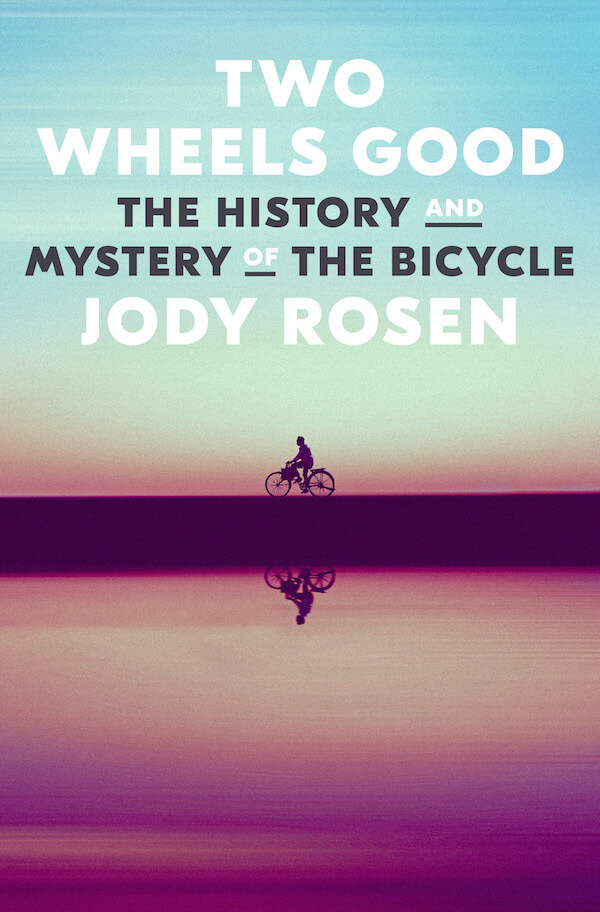Autumn Gear Guide
Find inspiration in our Gear Guide that will keep you out on your bike through wind or rain.
Download NowReading Two Wheels Good: The History and Mystery of the Bicycle by Jody Rosen is like taking a long, satisfying bike ride: The terrain changes with every chapter, and you have no idea what you’ll discover on the next page. Each sentence barrages the reader with sights and sensations, but there’s no question you’re still […]
Reading Two Wheels Good: The History and Mystery of the Bicycle by Jody Rosen is like taking a long, satisfying bike ride: The terrain changes with every chapter, and you have no idea what you’ll discover on the next page. Each sentence barrages the reader with sights and sensations, but there’s no question you’re still on the same journey, from start to finish. As you close the back cover, you are left exhausted and happy, marveling at how far you’ve come.
“I honestly wanted to write about [cycling] for 20 years,” says Jody Rosen, a prolific freelance journalist based in New York City. “The bicycle is how I get around, and I’ve always been very interested, not just in bikes and their place in the world, but in the literature of the bicycle. I’ve kind of vacuumed up a lot of books about bicycles over the years, especially history stuff.”
Two Wheels Good starts out as a fairly standard origin story: We learn about the dandy horse, the penny-farthing, the safety bike, and pneumatic tires. Roads get paved and bicycle clubs are founded. Popularity surges, and Victorian celebrities embrace the pedaling lifestyle – until the invention of the combustion engine, when the streets are suddenly flooded with cars.
Generally, the book speaks to its title: Bicycles are good, improving urban life and fostering healthier people. Rosen connects cycling to first-wave feminism. He narrates love stories that started as bike tours. He quotes famous people, from Susan B. Anthony to Hemingway, who all praised the bicycle’s virtues. Rosen himself is a lifelong cyclist, and although he has spent much of his career writing about music for the likes of New York magazine and Slate, Two Wheels Good reflects a more personal passion.
But Rosen’s book takes unexpected turns: One chapter is devoted entirely to historic newspaper articles, which illustrate how the popular perception of cycling soured at the end of the 19th Century. Another chapter profiles a Bangladeshi rickshaw driver, who spends his life battling gridlock traffic for pennies a day. The most startling section delves into the world of cycling fetishism and a range of sexual practices that revolve around the bike.

“There were some holes in the historiography,” says Rosen. “A lot of the books I read about the bicycle were either super dated or were a very sentimental strain of literature. They pictured the bicycle as this uniformly great thing, [which] felt a little puerile to me. I was trying to provide a more balanced account.”
Indeed, Two Wheels Good offers a far more critical assessment of the bicycle’s evolution, warts and all. On the one hand, we see the rise of bicycle rights groups and the efforts of Critical Mass to take back the streets. On the other hand, we see European canals clogged with abandoned frames; latex farmers toiling to cultivate tire rubber and China’s radical shift from cycling paradise to motortopia.
Rosen is particularly critical of his home turf. Because New York is so famous for subways, yellow cabs, and pedestrian traffic, millions of Americans assume that the city is also ripe for cycling. Yes, the Citi Bike program is helpful, and yes, a network of bike lanes now exists. But cycling remains dangerous and impractical for most New Yorkers, and Rosen is dissatisfied with the rate of progress.
“New York is an ideal environment for cycling because it’s a dense city,” says Rosen. “The roads here could work really well. New York could be a Copenhagen or Amsterdam kind of place. What it would involve is the building of lots more protective lanes and redesigning the streets in all the obvious ways: getting rid of free curbside parking and eliminating – in many central areas – street parking altogether. Making things into greenways, pedestrian walkways, roads that are just for bicycles. That kind of thing is absolutely possible, you just need the will. And I think what people would discover is how much better New York could be.”
In the end, though, Two Wheels Good remains a kind of love letter to the bicycle, in all its complexity. Rosen is hopeful that the cycling boom will continue, and he describes e-bikes as “the single most important development since the safety bike.”
“I definitely think the movement we’re seeing in the American cities and Western Europe around cycling infrastructure is super exciting,” he says. “What’s going on in Paris is extremely exciting and a model for what’s going on around the world. It’s people of lesser means and marginalized groups that need bicycles more because they’re the victims of unsafe streets and traffic accidents and a climate that’s in collapse. We need to do a better job in general of making sure that all the benefits of cycling cities are spread wide, across class lines.”
Click here to purchase Two Wheels Good by Jody Rosen.
Find inspiration in our Gear Guide that will keep you out on your bike through wind or rain.
Download Now
Leave a comment